2016 TOYOTA TUNDRA overheating
[x] Cancel search: overheatingPage 89 of 588

892. Instrument cluster
2
Instrument cluster
The brightness of the instrument panel lights can be adjusted by turn-
ing the “ODO/TRIP” button.Darker
Brighter
Instrument panel light control
1
2
NOTICE
■To prevent damage to the engine and its components
● Do not let the indicator needle of the tachometer enter the red zone, which
indicates the maximum engine speed.
● The engine may be overheating if the engine coolant temperature gauge is
in the red zone (H). In this case, immediately stop the vehicle in a safe
place, and check the engine after it has cooled completely. ( P. 505)
Page 151 of 588
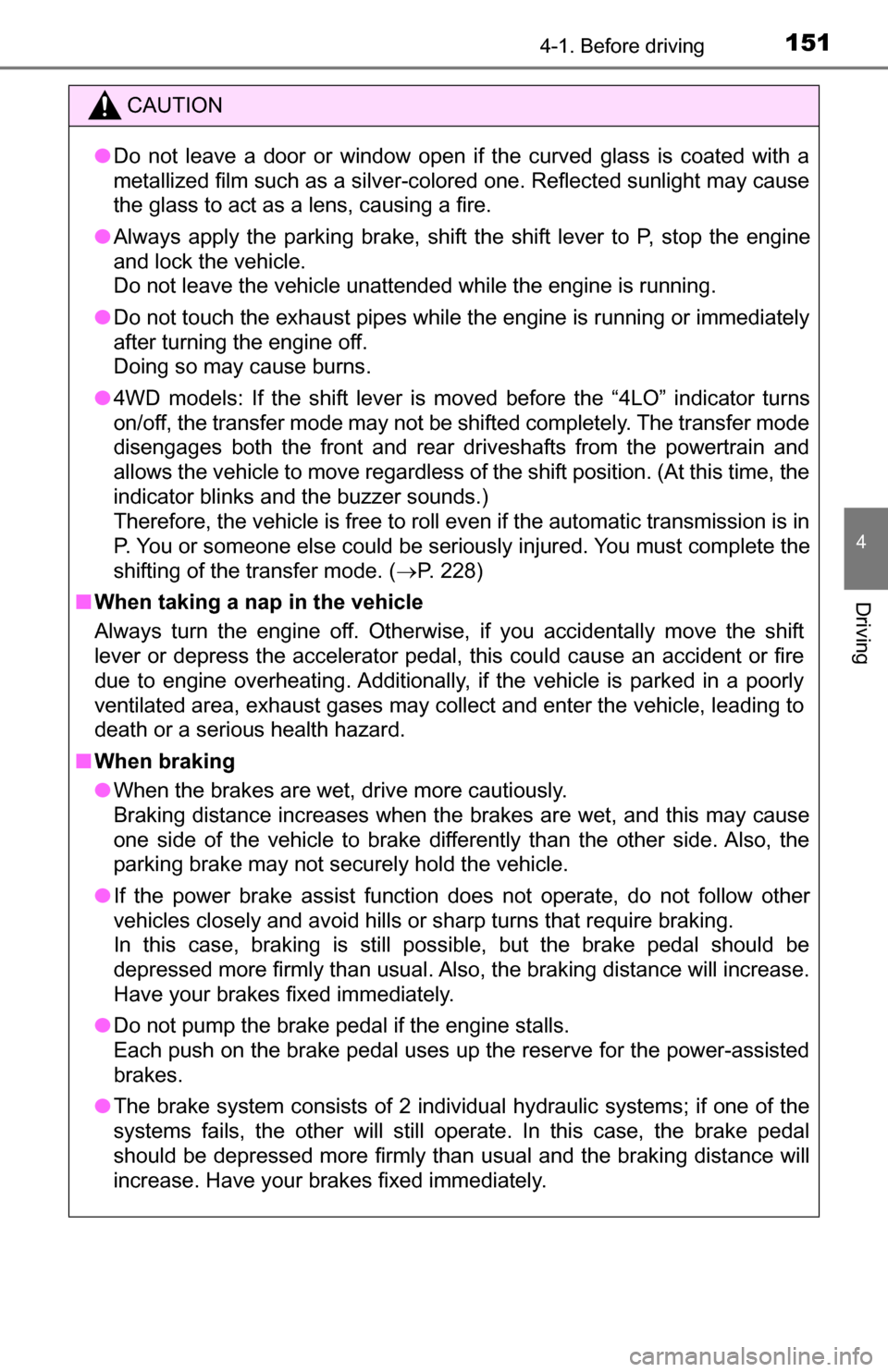
1514-1. Before driving
4
Driving
CAUTION
●Do not leave a door or window open if the curved glass is coated with a
metallized film such as a silver-colored one. Reflected sunlight may cause
the glass to act as a lens, causing a fire.
● Always apply the parking brake, shift the shift lever to P, stop the engine
and lock the vehicle.
Do not leave the vehicle unattended while the engine is running.
● Do not touch the exhaust pipes while the engine is running or immediately
after turning the engine off.
Doing so may cause burns.
● 4WD models: If the shift lever is moved before the “4LO” indicator turns
on/off, the transfer mode may not be shifted completely. The transfer mode
disengages both the front and rear driveshafts from the powertrain and
allows the vehicle to move regardless of the shift position. (At this time, the
indicator blinks and the buzzer sounds.)
Therefore, the vehicle is free to roll even if the automatic transmission is in
P. You or someone else could be seriously injured. You must complete the
shifting of the transfer mode. ( P. 228)
■ When taking a nap in the vehicle
Always turn the engine off. Otherwise, if you accidentally move the shift
lever or depress the accelerator pedal, this could cause an accident or fire
due to engine overheating. Additionally, if the vehicle is parked in a poorly
ventilated area, exhaust gases may collect and enter the vehicle, leading to
death or a serious health hazard.
■ When braking
● When the brakes are wet, drive more cautiously.
Braking distance increases when the brakes are wet, and this may cause
one side of the vehicle to brake differently than the other side. Also, the
parking brake may not securely hold the vehicle.
● If the power brake assist function does not operate, do not follow other
vehicles closely and avoid hills or sharp turns that require braking.
In this case, braking is still possible, but the brake pedal should be
depressed more firmly than usual. Also, the braking distance will increase.
Have your brakes fixed immediately.
● Do not pump the brake pedal if the engine stalls.
Each push on the brake pedal uses up the reserve for the power-assisted
brakes.
● The brake system consists of 2 individual hydraulic systems; if one of the
systems fails, the other will still operate. In this case, the brake pedal
should be depressed more firmly than usual and the braking distance will
increase. Have your brakes fixed immediately.
Page 175 of 588

1754-1. Before driving
4
Driving
●Avoid sudden braking as you may skid, resulting in the trailer jack-
knifing and a loss of vehicle control. This is especially true on wet or
slippery surfaces.
● Avoid jerky starts or sudden acceleration.
● Avoid jerky steering and sharp turns, and slow down before making
a turn.
● Note that when making a turn, the trailer wheels will be closer than
the vehicle wheels to the inside of the turn. Compensate by making
a wider than normal turning radius.
● Slow down before making a turn, in crosswinds, on wet or slippery
surfaces, etc.
Increasing vehicle speed c an destabilize the trailer.
● Take care when passing other vehicles. Passing requires consider-
able distance. After passing a vehi cle, do not forget the length of
your trailer, and be sure you hav e plenty of room before changing
lanes.
● To maintain engine braking efficiency and charging system perfor-
mance when using engine braking, do not use the transmission in
D.
Transmission shift range positi on must be in 4 in the S mode.
● Instability happens more frequently when descending steep or long
downhill grades. Before descending, slow down and downshift. Do
not make sudden downshifts while descending steep or long down-
hill grades.
● Avoid holding the brake pedal down too long or applying the brakes
too frequently. This could cause the brakes to overheat and result in
reduced braking efficiency.
● Due to the added load of the trailer, your vehicle’s engine may over-
heat on hot days (at temperatures over 85°F [30°C]) when driving
up a long or steep grade. If t he engine coolant temperature gauge
indicates overheating, immediately turn off the air conditioning (if in
use), pull your vehicle off the road and stop in a safe spot.
( P. 505)
Page 190 of 588
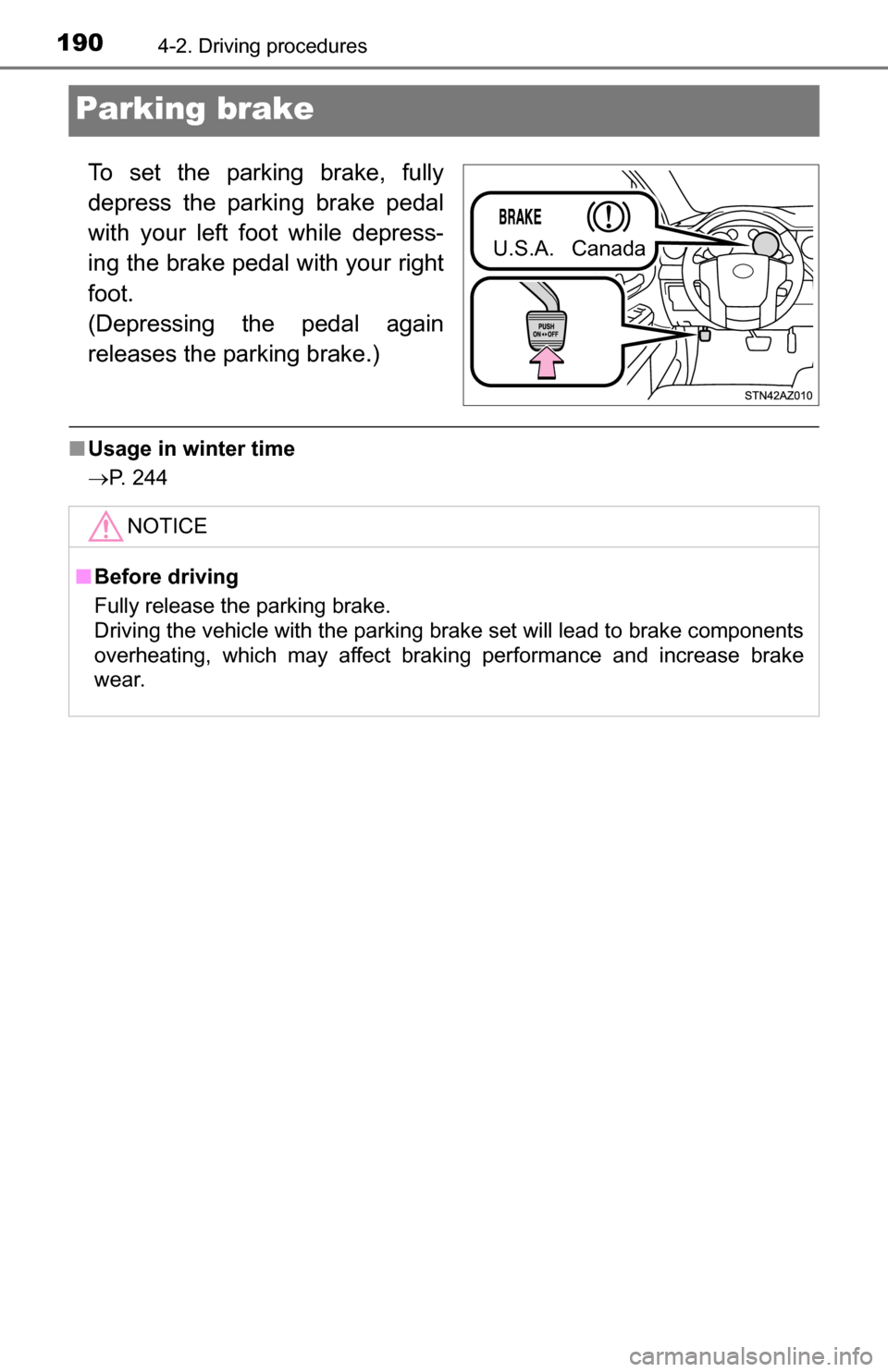
1904-2. Driving procedures
Parking brake
To set the parking brake, fully
depress the parking brake pedal
with your left foot while depress-
ing the brake pedal with your right
foot.
(Depressing the pedal again
releases the parking brake.)
■Usage in winter time
P. 244
U.S.A. Canada
NOTICE
■
Before driving
Fully release the parking brake.
Driving the vehicle with the parking brake set will lead to brake components
overheating, which may affect braking performance and increase brake
wear.
Page 359 of 588
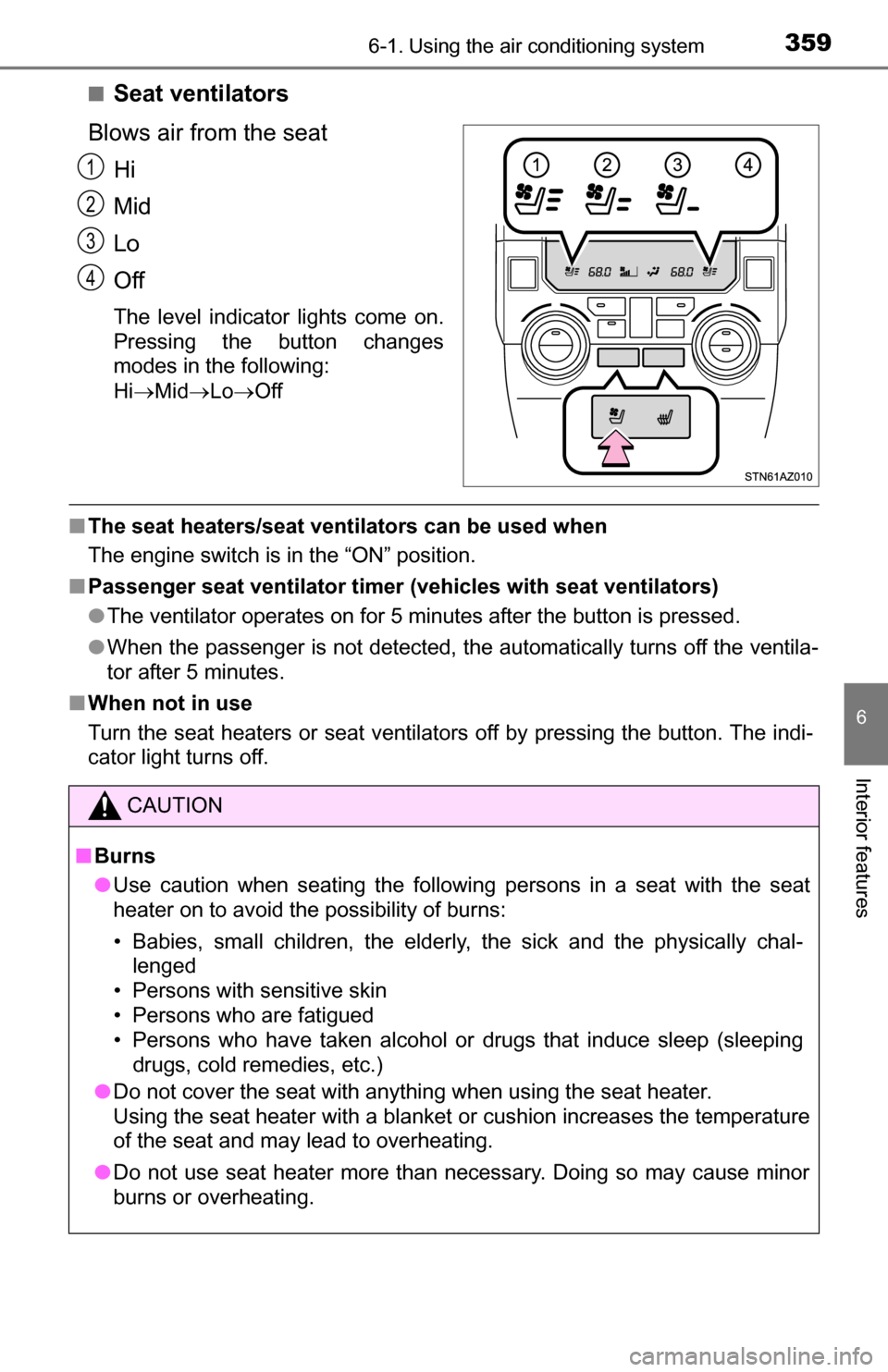
3596-1. Using the air conditioning system
6
Interior features
■Seat ventilators
Blows air from the seat Hi
Mid
Lo
Off
The level indicator lights come on.
Pressing the button changes
modes in the following:
HiMid LoOff
■The seat heaters/seat ventilators can be used when
The engine switch is in the “ON” position.
■ Passenger seat ventilator timer ( vehicles with seat ventilators)
● The ventilator operates on for 5 minutes after the button is pressed.
● When the passenger is not detected, the automatically turns off the ventila-
tor after 5 minutes.
■ When not in use
Turn the seat heaters or seat ventilators off by pressing the button. The indi-
cator light turns off.
1
2
3
4
CAUTION
■Burns
● Use caution when seating the following persons in a seat with the seat
heater on to avoid the possibility of burns:
• Babies, small children, the elderly, the sick and the physically chal-
lenged
• Persons with sensitive skin
• Persons who are fatigued
• Persons who have taken alcohol or drugs that induce sleep (sleeping drugs, cold remedies, etc.)
● Do not cover the seat with anything when using the seat heater.
Using the seat heater with a blanket or cushion increases the temperature
of the seat and may lead to overheating.
● Do not use seat heater more than necessary. Doing so may cause minor
burns or overheating.
Page 505 of 588
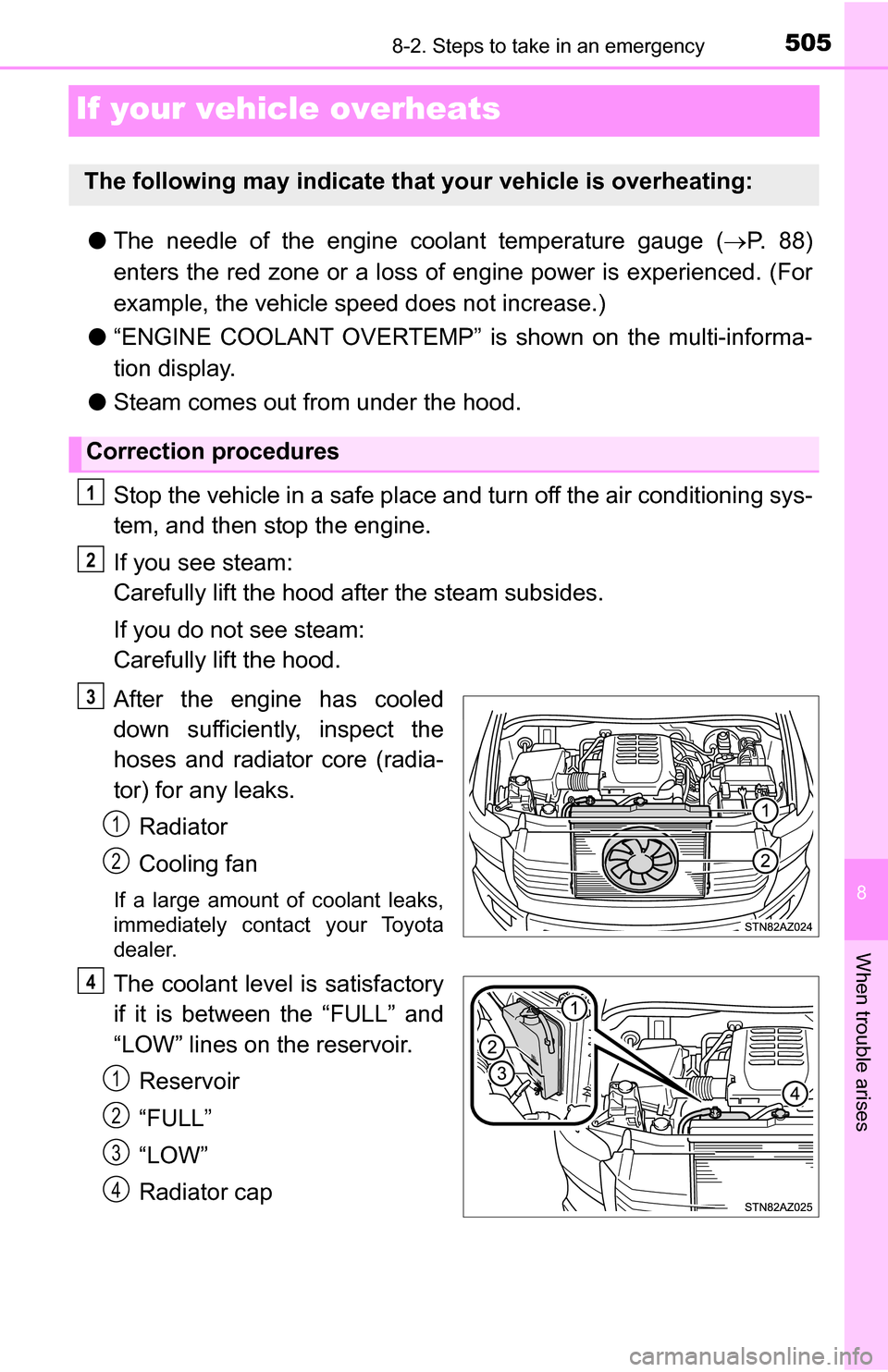
505
8
When trouble arises
8-2. Steps to take in an emergency
If your vehicle overheats
●The needle of the engine coolant temperature gauge ( P. 8 8 )
enters the red zone or a loss of engine power is experienced. (For
example, the vehicle sp eed does not increase.)
● “ENGINE COOLANT OVERTEMP” is shown on the multi-informa-
tion display.
● Steam comes out from under the hood.
Stop the vehicle in a safe place and turn off the air conditioning sys-
tem, and then stop the engine.
If you see steam:
Carefully lift the hood after the steam subsides.
If you do not see steam:
Carefully lift the hood.
After the engine has cooled
down sufficient ly, inspect the
hoses and radiator core (radia-
tor) for any leaks.
Radiator
Cooling fan
If a large amount of coolant leaks,
immediately contact your Toyota
dealer.
The coolant level is satisfactory
if it is between the “FULL” and
“LOW” lines on the reservoir.Reservoir
“FULL”
“LOW”
Radiator cap
The following may indicate that your vehicle is overheating:
Correction procedures
1
2
3
1
2
4
1
2
3
4
Page 575 of 588
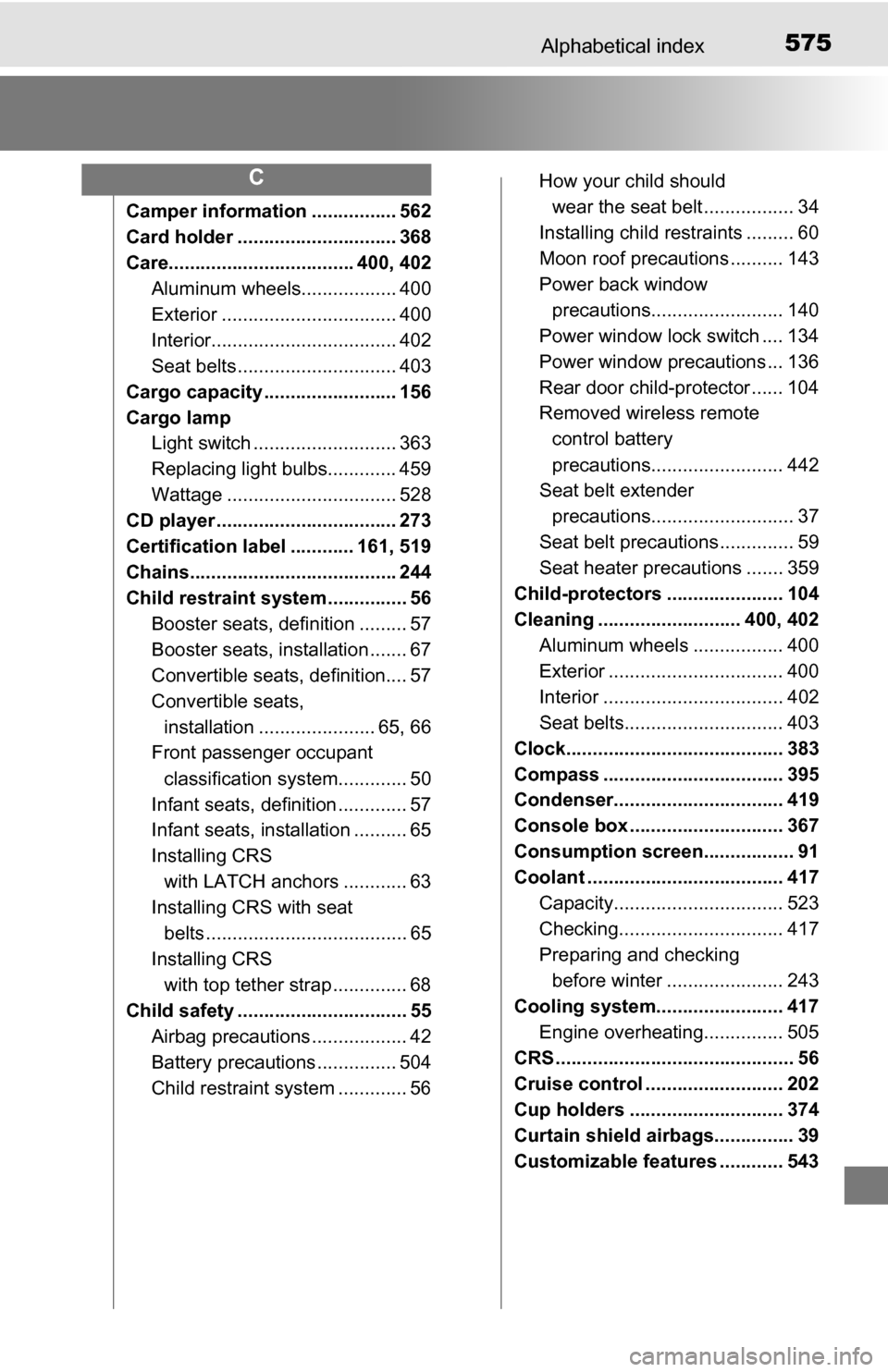
575Alphabetical index
Camper information ................ 562
Card holder .............................. 368
Care................................... 400, 402Aluminum wheels.................. 400
Exterior ................................. 400
Interior................................... 402
Seat belts .............................. 403
Cargo capacity ......................... 156
Cargo lamp Light switch ........................... 363
Replacing light bulbs............. 459
Wattage ................................ 528
CD player .................................. 273
Certification label ............ 161, 519
Chains....................................... 244
Child restraint system ............... 56
Booster seats, definition ......... 57
Booster seats, installation ....... 67
Convertible seats, definition.... 57
Convertible seats, installation ...................... 65, 66
Front passenger occupant
classification syst em............. 50
Infant seats, definition ............. 57
Infant seats, installation .......... 65
Installing CRS with LATCH anchors ............ 63
Installing CRS with seat
belts ...................................... 65
Installing CRS with top tether strap .............. 68
Child safety ................................ 55 Airbag precautions .................. 42
Battery precautions ............... 504
Child restraint system ............. 56 How your child should
wear the seat belt ................. 34
Installing child restraints ......... 60
Moon roof precautions .......... 143
Power back window
precautions......................... 140
Power window lock switch .... 134
Power window precautions ... 136
Rear door child-protector ...... 104
Removed wireless remote
control battery
precautions......................... 442
Seat belt extender
precautions........................... 37
Seat belt precautions .............. 59
Seat heater precautions ....... 359
Child-protectors ...................... 104
Cleaning ........................... 400, 402 Aluminum wheels ................. 400
Exterior ................................. 400
Interior .................................. 402
Seat belts.............................. 403
Clock......................................... 383
Compass .................................. 395
Condenser................................ 419
Console box ............................. 367
Consumption screen................. 91
Coolant ..................................... 417 Capacity................................ 523
Checking............................... 417
Preparing and checking before winter ...................... 243
Cooling system........................ 417 Engine overheating............... 505
CRS ............................................. 56
Cruise control .......................... 202
Cup holders ............................. 374
Curtain shield airbags............... 39
Customizable features ............ 543
C
Page 576 of 588

576Alphabetical index
Daytime running light system .................................... 193
Deck hooks .............................. 381
Defogger Back window ................. 346, 353
Outside rear view mirrors ........................ 346, 353
Windshield .................... 346, 353
Differential ................................ 524
Dimensions .............................. 510
Dinghy towing .......................... 181
Display Multi-information display ......... 90
Trip information ....................... 91
Warning message ................. 480
Do-it-yourself maintenance .... 411
Doors ........................................ 100
Automatic door locking and unlocking system ......... 104
Door glasses ......................... 134
Door lock............................... 103
Open door warning light........ 474
Open door warning message ............................. 481
Outside rear view mirrors...... 130
Rear door child-protector ...... 104
Side doors............................. 100
Driver’s seat position
memory .................................. 116
Driving ...................................... 146 Break-in tips .......................... 147
Correct driving posture ........... 30
Driving assist system ............ 233
Procedures ........................... 146
Winter drive tips .................... 243 EDR (Event data recorder)........ 10
Emergency, in case of
If the engine will not start ...... 499
If the shift lever cannot be shifted from P .... 500
If the vehicle has discharged battery ................................ 502
If the warning buzzer sounds................................ 473
If the warning light turns
on ....................................... 473
If the warning message is displayed ........................ 480
If you have a flat tire ............. 484
If you lose your keys ............... 98
If you think something is wrong .............................. 471
If your vehicle becomes stuck ................................... 507
If your vehicle has to be stopped in an emergency ... 465
If your vehicle needs
to be towed......................... 466
If your vehicle overheats....... 505
Emergency flashers ................ 464
Engine
“ACC” position ...................... 182
Compartment ........................ 414
Engine switch ....................... 182
Hood ..................................... 413
How to start the engine......... 182
Identification number ............ 519
If the engine will not start ...... 499
Ignition switch (engine switch) ................... 182
Immobilizer system .. ............... 78
Overheating .......................... 505
DE